On June 24, 2022, the United States Supreme Court handed down Dobbs v. Jackson Women’s Health Organization, No. 19-1392, 597 U.S. 215 (2022), overturning Roe v. Wade (1973) and Planned Parenthood v. Casey (1992). The 6-3 majority held that the United States Constitution does not provide a right to an abortion. This article provides a 50-state survey of the less commonly discussed private civil causes of action potentially arising from or relating to abortion procedures.
We first summarize the basic elements of a civil cause of action.
Standing
Standing is the capacity of a plaintiff to bring a lawsuit. Typically, standing requires an injury to a legally cognizable interest. With civil causes of action, the statute almost always grants standing. The following parties commonly have standing:
- The patient;
- The fetus’s father;
- The fetus’s maternal grandparents, or the minor patient’s guardian(s);
- The unborn child, through their estate, or “born alive” child;
- Other family;
- Solicitors, prosecutors, and the attorney general; and
- All citizens, except for state employees.
Liable Party
Liable party is the person who, or entity which, can be sued. The liable party always includes the abortion provider but may extend to individuals aiding in abortions, facility administrators, executives, and even insurance providers covering abortion costs. Certain jurisdictions subject unauthorized providers or those encouraging mothers into abortion to civil liability.
One consistent feature across all statutes surveyed is that the person receiving the abortion is not held liable. This is usually explicitly stated in the statute.
Standard for Liability
The standard in any given jurisdiction is the level of culpability necessary for civil liability to attach. Standards range from negligence to intent, though various jurisdictions use functionally synonymous civil terms of purposeful, knowing, or intentional. These distinctions are important to understand, especially for attorneys who work in the negligence sphere, where the standard focuses on objective physician judgment.
The culpability standards are:
- Intentionally, or acting with the specific intent to achieve a certain outcome;
- Purposely, or seeking to achieve a specific outcome;
- Knowingly, or having awareness of the nature of one’s actions or the likely consequences;
- Reckless, or acting with a conscious disregard for a substantial and unjustifiable risk that one’s action will cause a certain outcome; and
- Negligence, failing to exercise the degree of care that a reasonable person would exercise in a similar circumstances, thereby causing harm to another person or property.
Remedies
The range of allowed damages includes the following:
- Compensatory (Actual) economic damages;
- Noneconomic damages;
- Statutory damages;
- Punitive damages;
- Injunctive relief; and
- Reasonable court costs and attorney’s fees.
Often, the relevant statute will refer to other parts of the law allowing recovery under medical malpractice or wrongful death claims, thereby incorporating the remedies from that type of action into the respective statute.
Causes of Action—Conduct Leading to Liability
Most states regulate abortion providers’ conduct. Regulations violated can give rise to civil liability. This section discusses the following statutory restrictions and requirements: trigger age, procedure type, consent compliance, and a miscellaneous other triggers category. We begin by outlining these broad categories and describing the more specific limitations within them.
Exceptions to liability for abortion providers commonly exist when an abortion is necessary to save the life of the patient, when carrying the child to term presents a serious health risk to the patient, when the unborn child suffers a lethal anomaly, and when the pregnancy resulted from rape or incest.
Trigger Age
Statutorily set gestation ages are herein referred to as trigger ages for their ability to trigger a cause of action if an abortion is performed. Dobbs permits state legislatures to create causes of actions with earlier trigger ages, particularly in the timeframe below 20 weeks—trigger ages that were constitutionally protected under Roe. The trigger age giving rise to liability varies by state.
Some states have multiple laws setting these trigger ages. In some cases, the statute with the greater trigger age simply existed prior to Dobbs—or even Roe—and remains in the code. Earlier in term trigger ages may be inclusive of later term causes of action, creating multiple claims options. See Figure 1, Cause of Action Overlap. No meaningful correlation exists between gestational age and standards of liability or severity in damages.
Note that the statute of limitations for abortion causes of action is generally based on that of personal injury for the associated jurisdiction.

Conception/Fertilization
A trigger age of “conception/fertilization” exists if an abortion is performed once a male sperm cell joins with a female egg cell, forming a fertilized egg. Fertilization can happen within hours or up to five days after sperm enters the vagina. Only Louisiana has a clear cause of action based on conception/fertilization. See Figure 2.
Most conception/fertilization trigger laws carve out provisions for birth control devices or oral contraceptives, like the use of “Plan B, morning-after pills, or any other type of contraception or emergency contraception.”
Standing, standards, and remedies vary greatly across states.
Fetal “Heartbeat”
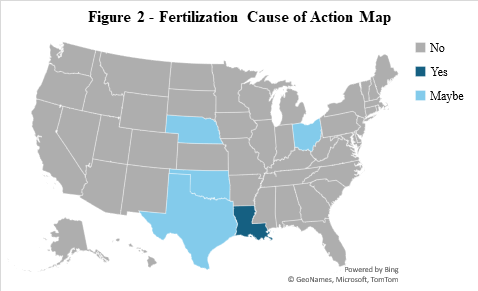
States with “heartbeat” restrictions create a cause of action as soon as there is a detectable embryonic or fetal cardiac activity, as seen in Figure 3. This typically occurs around six weeks postfertilization. Despite 16 states having bans on abortions at six weeks post-fertilization or earlier, only seven states attach a civil cause of action to the ban. While the standing of the patient is applicable in all seven states with heartbeat trigger ages, some, like Idaho, extend standing to a broader range of individuals. Importantly, some states grant standing for injunctive relief to a wider range of plaintiffs than those immediately impacted by an abortion.

The standard is most commonly knowing or intentional conduct. Available remedies differ across states. While some states specify statutory damages, others leave the determination of damages to the discretion of the court.
Intermediate Gestation Ages: Kentucky and North Carolina have trigger ages providing causes of action for abortions performed after a fetus reaches 12 and 15 weeks, respectively.
“Pain-Capable” and Viability Abortions: Thirteen states impose civil liability on providers who perform an abortion when a fetus can feel pain or achieve viability outside the womb. Fetal pain capability commonly aligns with a trigger age between 20 to 24 weeks gestational age, as seen in Figures 4 and 5.
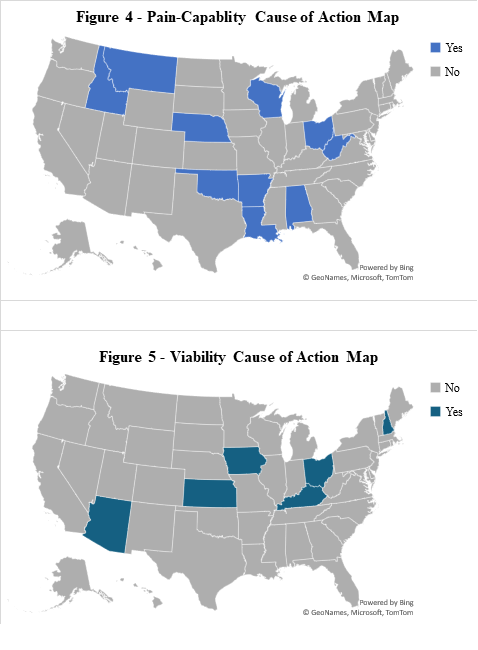
In nearly every pain-capability and viability statute the patient has standing to sue except under certain exceptions. In nine states, the fetus’s father may also have standing, particularly if married to the patient. The fetus’s maternal grandparents or minor patient’s guardians occasionally have standing. Some states provide standing for injunctive relief to a wider range of plaintiffs than those immediately impacted by an abortion.
The standard for abortion providers at the trigger age of pain capability or viability varies across jurisdictions. The standard encompasses intentional, knowing, or reckless conduct.
Ten states offer remedies to the plaintiff of actual or punitive damages, compensatory damages for personal injury, emotional, and psychological distress, injunctive relief, and reasonable attorney’s fees. Louisiana presents a civil fine remedy exclusively available through the attorney general. The remaining states’ remedies vary.
Procedure Type
Procedure type restrictions are generally related to actions for injury to person. The statute of limitations associated with these types or restrictions are based on that of personal injury for the associated jurisdiction.

- Chemical, Medication, or Drug Induced Abortions: These only occur up to 10 weeks gestation. Only states with fertilization and heartbeat restrictions could impact the civil liability of chemical abortions. The law is unclear on the legality of a chemical abortion procedure; see Figure 6 for more information. Generally, the patient, spouse, and the minor patient’s guardians have standing. Chemical abortions most commonly require a reckless standard.
- Partial Birth Abortions, technically known as Intact Dilation and Extraction (often abbreviated as D&X, IDX, or intact D&E): D&X of a fetus with a heartbeat was federally outlawed in most cases by the 2003 Partial Birth Abortion Ban Act (PBAA). Seventeen states have their own bans which create civil liability for providers; see Figure 7 for more information. The PBAA and most state statutes provide that the fetus’s father has standing, if he is the patient’s husband. A minor patient’s parents generally have standing, too. This is distinct from most other abortion causes of action where the patient exclusively has standing to sue. The standard for partial-birth abortions is almost always intentionally and knowingly. Some of the statutes create additional remedies on top of that provided by federal law, and others nearly mirror the federal PBAA.

- Dismemberment Abortions: This is a nonmedical term used to describe a procedure wherein the fetus is dissected into pieces with instruments in utero and extracted from the womb. In nine states, the patient, the father, and a minor patient’s guardian can sue to recover money damages for all injuries, psychological and physical, occasioned by the abortion and statutory damages equal to three times the cost of the procedure; more information is available in Figure 8. Standing, standards, and remedies for dismemberment abortions vary among other states.
Consent and Notification Requirements

Another common cause of action arises from consent. These cases may involve the issue of patient informed consent or legal guardian informed consent. Abortion consent and notification requirements as well as statutes of limitations generally follow those typically seen in medical malpractice actions.
Violation of Voluntary and Informed Consent Requirements: Thirteen states have statutes to ensure that the abortion provider obtains voluntary and informed consent from the patient, under threat of civil liability; see Figure 9 for more information.
The requirements for obtaining consent vary on a state-by-state basis. Some of the common elements are:
- Consent must be written;
- Provider must detail medical risks;
- Provider must respect a 24 to 72 hour-timeframe from informing the patient to providing the abortion;
- Provider must provide the probable gestational age of the fetus;
- Provider must explain the medical risks of carrying child to term;
- Provider must perform an ultrasound, and the patient must be provided the opportunity to view the ultrasound; and
- Patient must have the opportunity to listen to the fetal heartbeat.
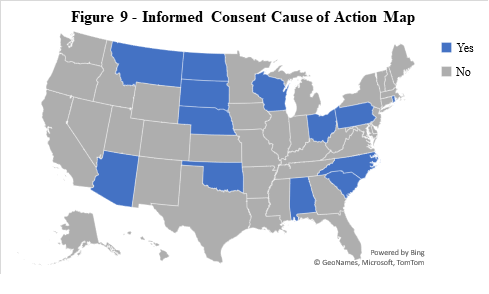
Most of these statutes also require that written information published by respective state health boards be given to patients. Other provisions include providing the name and contact information of the physician who will perform the abortion and marital status certification. No meaningful patterns in standing, standard, and remedies exist in the informed consent causes of action. Standards include simple negligence, gross negligence, wantonness, willfulness, and intention. Remedies include compensatory damages, punitive damages, and sometimes injunctive relief. The amount of damages and the specific types allowed vary.
Violation of Parental Consent and/or Notification Requirements
In addition to the informed consent requirements above, 20 states have additional requirements—and resulting causes of action—if the patient receiving the abortion is an unemancipated minor, as defined by the state; more information can be found in Figure 10. The consent age is most commonly 18 years of age. In circumstances with a minor patient, the law may impose a requirement that the minor-patient’s parent(s) either be notified that the patient will receive an abortion, or in some states, the parent(s) must consent to the abortion.
The following describes the typical notification, consent, and bypass mechanisms:
- Legal guardians are notified before a minor can obtain an abortion;
- Legal guardians must give written and notarized consent;
- The court holds a confidential judicial bypass hearing to determine whether the minor is mature enough to make the decision on her own; and,
- Provider must verify proof of paternity.
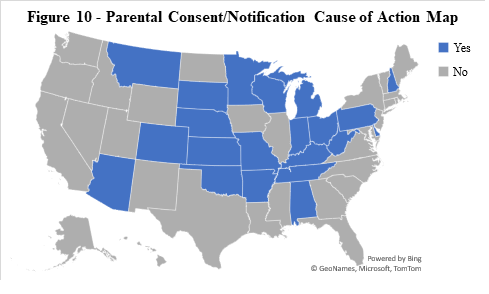
Other parental consent statutes mandate timeframes for decision-making, confidentiality, notarization, and record-keeping. No meaningful patterns in standard and remedies exist.
Spousal Consent Requirement in Pennsylvania
Pennsylvania provides a distinct cause of action if the abortion provider fails to seek consent from the spouse of the patient. The statute operates like the Parental Consent statutes.
Other Actions Giving Rise to Civil Liability
Some other triggers to civil liability exist under state law including:
- Born-Alive Abortion: Liability exists in 12 states; for more information, see Figure 11. Common provisions of state statutes include duty to provide typical standard of care, ability to transfer the born alive infant to the hospital, protecting the fetus from harm, reporting requirements, and confidentiality protections.
- Discriminatory Abortions: Liability exists in 10 states for providers who perform abortions based on genetic factors, such as the fetus’s sex, race, national origin, or disability; for more information see Figure 12.
- Aiding and Abetting: Indiana and Texas outlaw conduct such as paying for or reimbursing the costs of an abortion through insurance or otherwise.
- Selling/Disposition of Fetal Remains: In Alabama, the sale, disposition, or experimentation upon bodily remains from an abortion may give rise to civil liability.
- Signage Requirements: Oklahoma is the only state attaching civil liability to actions violating sign requirements related to coercion and chemical abortions.
- Abortion Provider Admitting Privileges: Wisconsin provides a cause of action for physicians who perform an abortion without having admitting privileges in a hospital within 30 miles of the location where the abortion is to be performed.
- Refusal of Provider to Perform an Abortion: Maryland law contradicts the post-Dobbs trend by providing that an abortion provider may be held civilly liable for refusing to perform an abortion where one is required by the standard of care.
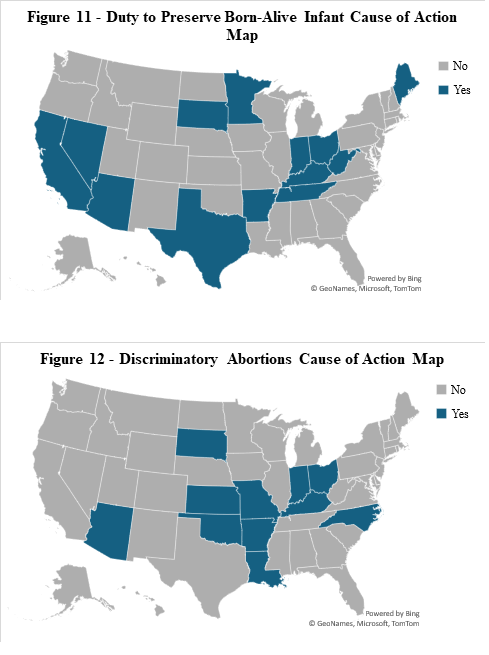
Conclusion
This survey reveals that aside from criminal liability, medical providers and other parties may face civil liability for providing or facilitating abortions. Furthermore, there is an indirect correlation between criminal abortion laws and civil causes of action—some states have severe criminal restrictions and minimal civil liability, while other states do not criminalize abortion but enforce abortion restrictions through civil causes of action.